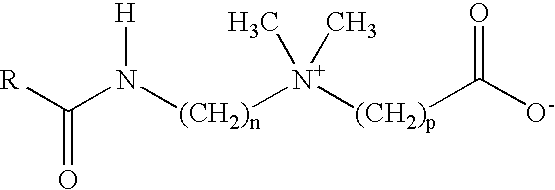Method for Treating a Subterranean Formation
a subterranean formation and subsurface technology, applied in the field of improving the production of fluids, can solve the problems of failure to produce, reduce the effective permeability (flow capacity) of the formation, and the inability to control precipitation reactions
- Summary
- Abstract
- Description
- Claims
- Application Information
AI Technical Summary
Benefits of technology
Problems solved by technology
Method used
Image
Examples
examples
[0081]The following examples illustrate some methods of the present invention, as described in the detailed description.
[0082]The following slurry test technique was conducted to determine aluminum silicate dissolution in examples 1 through 18. Using a slurry reactor available from Parr Instrument Company, Moline, Ill., the test cell used is a modified 4500 series Parr pressure reactor, with a capacity of IL of fluid. The fluid in the reactor was stirred at 100 rpm using a 4 bladed impeller driven by a magnetic drive-coupled electric motor. The cell was also fitted with a 4″ dip tube to enable the acquisition of samples on a timed basis. The cell was also fitted with a backpressure regulator, which was set at 200 psi. The reactor cell and internal parts were constructed of Hastelloy B. All connecting lines were made of 316 SS and the heated transfer flask was made of Teflon coated 316 SS. About 75 mls of distilled water were placed into the reactor cup. A Teflon cup was placed insid...
examples 1-9
[0085]In examples 1 through 9, aqueous samples were prepared by mixing with water, 9% by weight formic acid, and 5% by weight ammonium bifluoride, all based upon total fluid weight. For examples 1, 4 and 7, seven percent by weight, based upon total fluid weight, of a solution of 36% by weight hydrochloric acid in water was incorporated, while for examples 3, 6 and 9, seven percent by weight, based upon total fluid weight, of a solution of 70% by weight methane sulfonic acid in water was incorporated. For each example, 500 ml of test sample were mixed with 70 g kaolinite clay. The test temperature for examples 1 through 3 was 80° C., for examples 4 through 6 was 100° C., and examples 7 through 9, 125° C. For each example, the elapsed dissolution test time was about 4 hours, and the test samples were stirred at 100 rpm. Results are given in table II as follows:
TABLE IIEx. 1Ex. 2Ex. 3Dissolved Aluminum Concentration7580 ppm 393 ppm5450 ppmDissolved Silicon Concentration 318 ppm3490 ppm...
examples 10-18
[0087]To further illustrate some other embodiments of the invention, in examples 10 through 18, aqueous samples were prepared by mixing with water, 13% by weight citric acid acid, 5% by weight ammonium bifluoride, and 2.5% by weight boric acid, all based upon total fluid weight. For examples 10, 13 and 16, four percent by weight, based upon total fluid weight, of a solution of 36% by weight hydrochloric acid in water was incorporated, while for examples 12, 15 and 18, four percent by weight, based upon total fluid weight, of a solution of 70% by weight methane sulfonic acid in water was incorporated. For each example, 500 ml of test sample were mixed with 70 g kaolinite clay. The test temperature for examples 10 through 12 was 80° C., for examples 13 through 15, 100° C., and examples 16 through 18, 125° C. For each example, the elapsed dissolution test time was about 4 hours, and the test samples were stirred at 100 rpm. Results are provided in table III, as follows:
TABLE IIIEx. 10E...
PUM
| Property | Measurement | Unit |
|---|---|---|
| temperatures | aaaaa | aaaaa |
| temperatures | aaaaa | aaaaa |
| temperatures | aaaaa | aaaaa |
Abstract
Description
Claims
Application Information
 Login to View More
Login to View More - R&D
- Intellectual Property
- Life Sciences
- Materials
- Tech Scout
- Unparalleled Data Quality
- Higher Quality Content
- 60% Fewer Hallucinations
Browse by: Latest US Patents, China's latest patents, Technical Efficacy Thesaurus, Application Domain, Technology Topic, Popular Technical Reports.
© 2025 PatSnap. All rights reserved.Legal|Privacy policy|Modern Slavery Act Transparency Statement|Sitemap|About US| Contact US: help@patsnap.com


